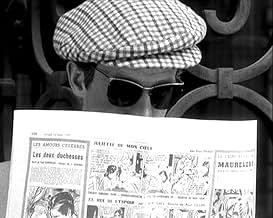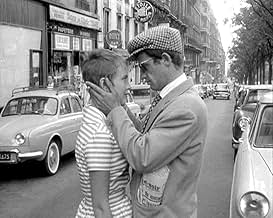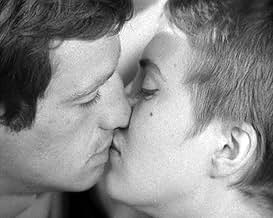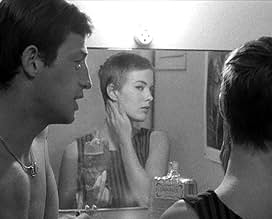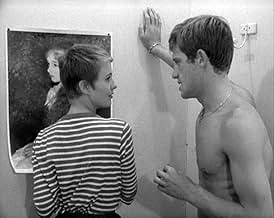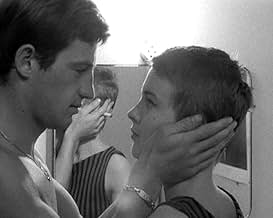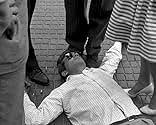Un ladrón de poca monta roba un coche y asesina de manera impulsiva a un motorista de la policía. Buscado por las autoridades, se reúne con una estudiante estadounidense de periodismo y trat... Leer todoUn ladrón de poca monta roba un coche y asesina de manera impulsiva a un motorista de la policía. Buscado por las autoridades, se reúne con una estudiante estadounidense de periodismo y trata de convencerla para que huya con él a Italia.Un ladrón de poca monta roba un coche y asesina de manera impulsiva a un motorista de la policía. Buscado por las autoridades, se reúne con una estudiante estadounidense de periodismo y trata de convencerla para que huya con él a Italia.
- Dirección
- Guión
- Reparto principal
- Nominado a 1 premio BAFTA
- 5 premios y 4 nominaciones en total
- Michel Poiccard a.k.a. Laszlo Kovacs
- (sin acreditar)
- Patricia Franchini
- (sin acreditar)
- Tolmatchoff
- (sin acreditar)
- Police Inspector Vital
- (sin acreditar)
- Photographer
- (sin acreditar)
- A Journalist
- (sin acreditar)
- Man in a White Car
- (sin acreditar)
- A Drunk
- (sin acreditar)
- A Journalist
- (sin acreditar)
- Liliane
- (sin acreditar)
- …
- Police Inspector #2
- (sin acreditar)
- The Snitch
- (sin acreditar)
- Carl Zubart
- (sin acreditar)
- Antonio Berrutti
- (sin acreditar)
- A Journalist
- (sin acreditar)
- Journalist at Orly
- (sin acreditar)
Reseñas destacadas
Still a wonderful introduction to the world of French cinema of the time, but needs to be taken in context as familiarity breeds contempt and this was, after all, part of the foundations and a cornerstone of so much of what was to come. Imaginatively and innovatively directed by one of the greatest, with two flowers of the 60s revealing their early petals, and after smoking so many cigarettes, is it any wonder you'd struggle to catch your breath!
Ironically, the pace of this movie isn't "breathless" at all. It begins abruptly and takes a while to get going: Michel (Jean-Paul Belmondo), a character we barely know, drives a stolen car around, talks at the camera, and shoots a police officer who has tried to pull him over. Then he goes to Paris and tries to borrow money from some friends, while the police-shooting plot goes undeveloped. I only became fully engaged with the introduction of Patricia (Jean Seberg), a young American who sells newspapers on the Champs-Elysees. The relationship between Michel and Patricia is the heart of the film, especially a 25-minute-long scene in Patricia's apartment where the characters smoke, flirt, and laze around in bed, though nothing really happens. That's where I really started to admire "Breathless," because I was so captivated by a scene that, on paper, doesn't sound all that captivating.
Eventually the police catch onto Michel and launch a manhunt, but this doesn't really ratchet up the suspense. Instead, Michel is (or at least, Michel acts) aimless and nonchalant about the whole thingthis is not a typical "man on the run" movie. The cool jazz score adds to the hip, laid-back tone.
Since I didn't care for the movie too much until the scenes between Michel and Patricia, I believe a lot of the credit for the film's success has to go to the charismatic performances of Belmondo and Seberg. Belmondo, with a perpetual cigarette dangling from the corner of his mouth, is the archetypal cocky criminal who models himself after Humphrey Bogart (there's a great scene where he sees some Bogart photos and gets a vulnerable look in his eyes, as though saying "I'll never be as cool as this"). Seberg plays Patricia as a confused girl who is delighted by the attention she gets as an American in France.
It's easy to see why "Breathless" was so influentialthe jump cuts, the ragged style perfectly match this story about amoral, aimless youth. Definitely a movie that expanded the range of stories the cinema can tell, and perhaps a major precursor to youth-oriented '60s culture. Nearly fifty years later, it still seems "hip," and still challenges our expectations of how movies should behave.
With his knowledge of classic film narrative and style Godard went out to create his own film in homage to, and also complete contradiction to, classic Hollywood film.
The plot reads almost like a crime thriller typical of the 1930-40's. A criminal on the run from the police; the distraction of a beautiful woman; the escape and eventually someones death. But it is in Godard's approach to film style and use of new technologies that the typical crime thriller was turned on its head.
In a break from classic Hollywood narrative the film opens with little equilibrium. Our protagonist's motives are unclear as he tears off to Paris leaving a woman and a dead cop in his trail. This in turn makes the ending somewhat open ended. With no sense of equilibrium to start with how can there be closure on what has happened throughout the film.
Another twist on the classic storytelling in film is the progression of plot. It is naturally assumed in classic Hollywood film, that everything the spectator sees they see for a reason. With Michel's constantly pointless phone calls to retrieve owed money the plot is not pushed along at all. The inclusion of a 25 minute digression from the plot stands to emphasise the spectators reliance on narrative structure in the watching of films. Although watching the film closely is, as always, important in following the story A Bout de Souffle requires that little bit extra to define where the plot is being progressed and where Michel or Patricia are just flattering their egos or each other.
All in all I personally think that A Bout de Souffle brought about a sense of realism not seen in Hollywood cinema before 1959 and even now. The fact that life isn't full of clues that will help us progress in say our relationships or escape from authority, but is infact full of digression; self exploration; and the confusions of love, ego and aspirations.
¿Sabías que...?
- CuriosidadesDespite reports to the contrary, Jean-Luc Godard did not shoot the film without a script; however, he did not have a finished script at the beginning, instead writing scenes in the morning and filming them that day. See also Pierrot, el loco (1965).
- PifiasDuring street shots, countless passersby look at Patricia and Michel and stare into the camera, revealing that the shots were made without filming barriers and simply used street pedestrians in place of extras.
- Citas
Patricia Franchini: What is your greatest ambition in life?
Parvulesco: To become immortal... and then die.
- ConexionesEdited into Pariz pripada nama! (2016)
Selecciones populares
Detalles
- Fecha de lanzamiento
- País de origen
- Idiomas
- Títulos en diferentes países
- Al final de l'escapada
- Localizaciones del rodaje
- 11 rue Campagne Première, Paris 14, París, Francia(on location)
- Empresas productoras
- Ver más compañías en los créditos en IMDbPro
Taquilla
- Presupuesto
- 400.000 FRF (estimación)
- Recaudación en Estados Unidos y Canadá
- 414.173 US$
- Fin de semana de estreno en EE. UU. y Canadá
- 32.424 US$
- 30 may 2010
- Recaudación en todo el mundo
- 596.100 US$
- Duración
- 1h 30min(90 min)
- Color
- Mezcla de sonido
- Relación de aspecto
- 1.37 : 1





